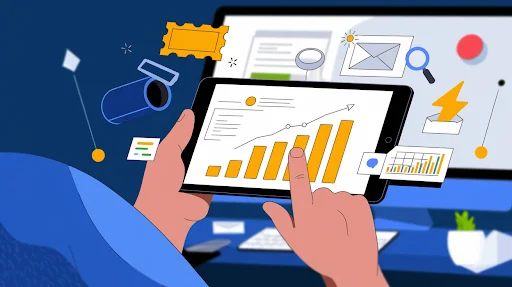The world of online marketing is lightning quick, but one thing seems consistent across it all: email still remains an unshakeable way to stay engaged with your people. Social network sites change their formulas, and trends pop up every other month, but email has this earthy, human quality that makes people listen. A well-delivered message landing in someone’s inbox feels less like an obnoxious billboard shouting down over you as you commute to work, but an invitation knocks on the doorstep.
Of course, there does need to be some strategy involved if you want email to work. These days, people are pickier, and overwhelmed by offers, newsletters, and general spam. If you send emails that sound like wallpaper paste, you’re going to get lost in no time. The good news is, that there are plenty out there that are specifically designed so you can send messages people won’t ignore. Below, let’s dive into seven tools that can get you streamlined from end to end.
Why Email Marketing Remains Important
In an era when social apps compete so vigorously for so many eyes, email feels old-fashioned. But there’s still an eternal quality to being able to drop a message squarely into an inbox. There’s no additional gatekeeper—no devious algorithm dictating whether you get delivered to someone’s feed. If you respect boundaries and offer quality, subscribers are going to remain engaged and continue clicking.
Another plus is ownership. Social media platforms can change terms overnight, but your list of emails belongs to you. Having that kind of power means you get to choose how frequently you communicate, how you segment out individuals, and how you optimize messages for increased relevance. People like that directness, especially if you provide them the perception you’re not just some brand throwing stuff out there trying to get clicks. It’s a dialogue, not an aggregate yell out there.
1. Campaign Monitor
Alright, so let’s talk about Campaign Monitor. Yeah, it’s one of those apps that makes email marketing less of an agony. It has an easy-to-use platform and comes with an option of well-designed email templates, so you get nice-looking campaigns even if you’re not naturally inclined toward design. You just drop content blocks wherever you need them, and the app does the heavy lifting.
What makes it so convenient, however, is the powerful analysis. You get to monitor who’s reading, click on which link, and even find out when it’s best to send. It’s data that allows you to optimize messages over time, so you don’t need to play it by ear. If you’re an outright novice, you can start out with basic functions and build toward the fancy stuff, like dynamic content by preference. In this way, whether you’re sending out an informal newsletter or an intricate sales campaign, you’re able to ramp up efforts without having to change over to another platform.
2. Brevo (formerly Sendinblue)
Brevo often comes up when people are discussing affordable but full-service email marketing. It’s not just newsletters, by the way—Brevo also takes care of SMS marketing, basic CRM capabilities, and Facebook ad management. This comes in handy if you’d rather not work with multiple tools just so you can track every way you’re connecting with people.
Newcomers to email marketing might find it surprisingly easy. You have an uncluttered dashboard with simple options to automate, send transactional emails, or build out lists. Because it’s so easy, you just get going, building out email sequences, never thinking you need coding school. If you ever need more complexity—like detailed segmentation or custom processes—you can head there when you get beyond level one. It’s an efficient bundle that scales, just as solo creatives, or small firms, need.
3. ConvertKit
ConvertKit is the default choice for creatives, whether podcasters, bloggers, or even graphical creatives seeking an easy way to engage fans. But you need not be any kind of content creator whatsoever to discover practical applications there. If you have a marketing method that relies heavily on narrative, or conveying substance-heavy news to an audience, ConvertKit’s plain, text-heavy method is one you’ll find delightful.
The first thing you’ll notice is how clean it feels compared to other email software. You won’t find yourself lost in an ocean of menus, or unrelated settings you didn’t need. What you’ll find, instead, are practical functions like email tagging, so you can categorize subscribers by what they click. Automation rules can be defined using an easy editor, so you can automate follow-ups, send targeted messages, or both, depending on subscriber behavior. If someone signs up for a mini-course, you can automatically send them relevant posts from your blog, or an eBook. It’s an efficient way to send email that keeps you engaged with people, not futzing over tricky setup steps.
4. Mailchimp
Mailchimp is one of those names you’ve heard over and over. It’s typically the first email marketing platform that novice entrepreneurs, or marketers, play around with, owing to its approachable, easy-going personality, as well as an added free option that keeps you going on the essentials. You churn out an email newsletter, add some personal touches through some nice drag-and-drop capabilities, and send it out relatively seamlessly.
Part of the beauty of Mailchimp lies in how it can integrate. If you’ve got an online store, you can plug it together with shopping sites and automate emails, say reminders if someone has an empty shopping cart, or reminders if you want reminders emailing them about products. It’s a lifesaver if you’re an individual shop wanting to stay in touch but not break the bank by spending money on heaps of other apps. The stats are also easy enough, showing you open, click-through, and demographic data in an easy-to-follow format. While there are plans that get expensive if you’ve got an enormous list, it still makes a great starting point if you’re just wading the waters of email marketing.
5. GetResponse
GetResponse is the one-stop-shop marketing hub. Besides email, you’re able to create full-on sales funnels, landing pages, and even host webinars. What this implies is you’re able to tackle several aspects of your online marketing strategy from one location, and if you’ve got multiple responsibilities within your company, this could be an enormous time-saver.
Its funnel builder is also very nice if you want to guide people from an initial registration all the way to a paid service or product. You can add follow-up email sequences, downsells, and upsells without duct-taping together multiple disparate tools. If you’re analytical, GetResponse has real-time reporting that tells you exactly where you’re losing people and where parts of your funnel are succeeding. That level of specificity is pure gold when you’re trying to optimize and ensure every email you send gets the kind of action you want—whether it’s scheduling a call, downloading an asset, or buying.
6. Omnisend
Omnisend is well-suited for the majority of e-commerce stores, but it’s also a great choice if you wish to employ multiple channels. It centralizes email, SMS, push messages, and other channels, so you get plenty of opportunities to stay visible to your users. You can send an offer via email, and later send out an SMS reminder to those who have shown an initial interest so that your marketing does not appear disjointed.
Automation is the backbone of Omnisend. You can automate scenarios like, “If someone adds an item to the cart but does not proceed to check out, send them an email three hours later, send them an SMS the next day.” That kind of multi-touch approach has the power to greatly decrease abandoned carts or incomplete sign-ups. While it’s targeted specifically toward online stores, the ability to mix channels comes useful also for service-based businesses. Maybe you send an email or send them a quick SMS to remind them for a consultive call/webinar. It’s just a matter of how you want to communicate, and it gives you the power to get it accomplished so there’s not too much complexity.
7. ActiveCampaign
ActiveCampaign often feels like the grownup version of email marketing software, mostly because it feels very automaton-focused and offers you tons of nuance when it comes to how you segment, or address, subscribers. If you find you enjoy building out very detailed, if-this-then-that automation, you might find that ActiveCampaign is the tool you’ve always wanted. It makes it possible for you to build out sequences that interact with users’ behavior across your website, emails, and other touchpoints.
Even though it has premium capabilities, it’s still not out of price range for small businesses. You start out on one of the starter plans, but you still get to enjoy basic automation. The further you move, you get more sophisticated instruments like website tracking, custom events tracking, and deeper CRM integration. The best thing, indeed, is that you get to address every single one of your subscribers as an individual by sending them messages targeted specifically toward their hobbies, past conversations, or other details. That kind of personalization has the power to lead to increased open rates, increased conversions, and longer, deeper relationships.
Wrapping It Up
Email marketing remains one of the greatest ways of building rapport and generating steady revenue over time. Social media might wow us with temporary spurts of connection, but there’s just something so personal about reading an elegantly worded email in one’s inbox. Whether you offer products, an online course, or just want to provide advice, the right platform has you showing up professionally while staying connected with those individuals you care about.
All seven of these products—Campaign Monitor, Brevo, ConvertKit, Mailchimp, GetResponse, Omnisend, and ActiveCampaign—each offer their brand of simplicity or sophistication. The question is, figure out where you’re at, and match that with an organization that feels authentic, has the automation you need, and fits your budget. Then you get to spend less time sweating the technical stuff, and you get to spend more time building those emails people just can’t wait to open. That’s when email marketing comes alive, and that’s when you get the effect it has over time.
Bio of author
Laura-Andreea Voicu is a copywriter and content marketer focused on developing brands through email newsletters and social media. She brings experience from hosting webinars and training sessions for entrepreneurs.







